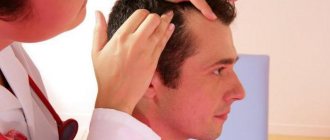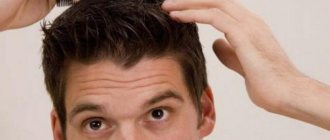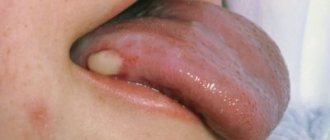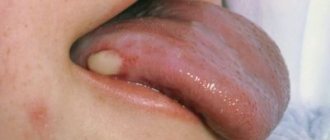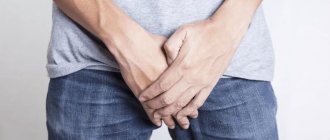Alopecia is hair loss that goes beyond the physiological norm, i.e. Alopecia means increased (not directly related to damage to the hair follicle) or pathological (related to damage to the hair follicle) hair loss.
As you know, in the life cycle of an individual hair there are several stages: growth, transition phase and loss. Under the influence of various factors, the duration of these phases can change, which leads to severe hair loss and baldness. This problem occurs in both men and women, and the success of treatment largely depends on the timeliness of seeking qualified, competent help.
Types of alopecia
There are several types of this process, each of them is characterized by its own characteristics.
Androgenetic
Among all, this disease ranks first; the disease leads to the loss of 96% of the hair on the head. This pathology is associated with a specific gene, inherited, which affects the frontal and parietal parts of the head.
The initial stage can be detected by the following factors: ● strands become discolored; ● become short and thin.
The reason for this development of events is the hormone dihydrotestosterone, which inhibits the normal functioning of the bulbs.
Diffuse
It occurs as a result of a disruption in the proper functioning of the body. There are different forms: 1. Anagen - hairs do not have time to fully go through any of the phases and begin to fall out at the growth stage. Appears due to exposure to poisons, chemotherapy, radiation. 2. Telogen - hair follicles go into the resting phase ahead of time. The cause is severe mental disorders and stress, poor diet and a number of hereditary diseases.
Focal
This species is also called nesting. A characteristic feature is a rounded lesion on the scalp. The disease occurs due to a malfunction of the immune system. The result is damage to the root follicles. Various viral diseases and strong emotional experiences can trigger the development of pathology.
What to do with this type of baldness in men. Treatment in this case can only help if some of the curls in the problem areas are still preserved.
Scar
In this case, the disease is triggered by viral infections, fungi and bacteria that develop on the hair and skin of the head. In some cases, pathology may begin after injury. If the bulbs are damaged, inflammation occurs, and as a result, the area becomes covered with connective tissue.
First signs
If you notice that you have shaggy areas, bald spots, bald spots and other imperfections instead of your once rich and luxurious head of hair, you need to think about the state of your health and urgently look for the mechanism that triggered the pathology. However, the listed signs are evidence of an activated process that has taken a pronounced course and is gaining speed of development.
However, there are also cases when a person, seeing a minimal loss, begins to panic and worry. In fact, a person normally loses a certain amount of their hair every day. Usually it is up to 150 units per day. It is important to separate the norm from the pathology and, if alarming signs are identified, contact a specialist in a timely manner.
On average, one hair lives 3–7 years. At the end of this period, it falls out, and a new one appears in its place. If you notice that after using a comb, some units remain directly on it, or you find them on the pillow after sleep, do not worry - this does not indicate the development of baldness and is not evidence of the disease. Also remember that our strands do not grow at the same time, they are constantly renewed. But there is a constant reserve on the head, 90% or more percent - it never runs out.
Before you look for the answer to the question of what helps hair loss in men, you need to determine whether you are actually going bald. Analyze your current state. This can be done using the simple tests described below:
1. Carefully examine your skin to see if patches of baldness are beginning to form. 2. Pull the curls - they should not separate easily. 3. Inspect your clothes, pillow after sleep, the back of your work chair, sofa, coat. How many hairs do you lose and how regularly do they appear there? 4. Monitor yourself during the washing procedure. Do large strands remain in the drain hole? Continue to monitor this for 2-3 weeks to confirm or deny the development of pathology. 5. Gently comb your hair. Carefully inspect individual units; if you see a white tip on them, you need to sound the alarm and start taking action, as this means the loss of vegetation at the root. This is usually a direct symptom of baldness.
Causes of alopecia in men
Determining them will allow you to radically change the condition of your hairstyle for the better. There are many ways that lead to alopecia: ● heredity; ● environmental pollution; ● consumption of nicotine and alcohol-containing drinks; ● serious mental disorders and constant stress; ● with poor nutrition - there is a deficiency of necessary elements; ● hormonal imbalances; ● sudden change in temperature; ● taking certain medications and the results of chemotherapy; ● improper care of curls.
All reasons over time lead to the fact that the follicles become weak and thinned over a long period. This leads to partial, and in the worst case, complete baldness.
Factors of occurrence
Thinning of strands does not happen spontaneously; it is preceded by a whole complex of reasons. In most cases, the influence is exerted by heredity and hormonal levels, but there are other common reasons for the development of the disease:
1. Dramatic weight loss due to strict diets; 2. Impaired functioning of the immune system, previous viral or infectious diseases; 3. Adverse environmental factors, poor ecology; 4. Malfunctions of the endocrine system; 5. Constant temperature changes; 6. Diabetes mellitus; 7. Menopause; 8. Previous surgical operations under general anesthesia; 9. Poor blood supply to the scalp; 10. Poor nutrition; 11. Lack of vitamins and microelements; 12. Bad habits; 13. Iron deficiency anemia; 14. Regular stress, severe emotional shocks; 15. Use of drugs to normalize blood pressure, steroids and diuretics, antidepressants; 16. Radiation and chemotherapy.
Forms of loss
There is no point in proving the fact that men’s hair thins out more often than women’s. According to statistics, approximately 25% of guys who reach the age of 30 begin to gradually lose their strands.
Experts identify 7 main stages of alopecia: 1. Normal hairstyle without any significant changes in the structure of the hairline. 2. Loss along a wedge-shaped curve. 3. Strands in the temporal and frontal areas stop growing at a normal pace. 4. In these same places, significant thinning of the strands is observed. 5. The density of curls decreases. 6. The stripes that connect the sides of the head disappear. 7. Complete loss of hair. The only exceptions may be the occipital and lower zones.
Having considered the main types and stages of baldness in men, a logical question arises - how can the disease be cured. There are methods and preparations that will significantly slow down the process and restore hair.
Folk remedies
Traditional medicine can be used to treat alopecia. In order for them to have at least some effect and not cause harm, you should use traditional recipes only after consulting a doctor.
Often, to prepare formulations for home use you will need:
- burdocks;
- onion;
- hop;
- hot pepper;
- burdock.
Masks with these components help strengthen hair roots and awaken dormant follicles.
To improve blood microcirculation, masks are used:
- from aloe, honey, garlic;
- mustard;
- red pepper.
Some traditional healers recommend rubbing regular salt into the scalp. The method helps exfoliate dead skin particles.
Traditional medicine is usually used in courses. Each is 2 weeks, then a break of 5–7 days is recommended.
How to stop hair loss
The first thing you need to do to start treatment is to establish the exact cause of the onset of alopecia. For this purpose, you should visit a specialist in this field - a trichologist. He will examine the skin of the scalp and carry out all the necessary diagnostic procedures. Only after this does the development of an individual program to get rid of the pathology begin.
Among the simplest and most popular recovery methods is scalp massage. It increases blood circulation, which promotes increased nutrition of the hair follicles, and this helps to prevent hair loss to some extent.
Always maintain good hygiene. Sebum accumulates on the curls and contributes to hair loss. Consider the fact that people who are experiencing active thinning of their curls need to use gentle shampoos.
Medication approach
Considering that alopecia is an irreversible process, there are remedies that can significantly slow it down, and sometimes even prevent it. Obviously, you shouldn’t expect immediate results, but gradually, after 6 or more months, the effect will become noticeable. There is one nuance here - as soon as a person stops using the drugs that stop the problem, it resumes.
Diagnostics
When a patient comes to a trichologist with complaints of alopecia areata, diagnostic measures are carried out for him. Examinations help determine the type and degree of the disease. Even if the problem cannot be completely overcome, there is an option to put it into remission and ensure the safety of your hair.
Patchy baldness requires immediate medical attention. The pathology is poorly understood, and it is important to find out the reasons at the very beginning in order to prescribe adequate therapy. The treatment process requires patience and compliance with the specialist’s instructions.
Diagnostics may include:
- blood test for hormones;
- biochemical and general blood tests;
- microscopic hair analysis;
- analysis of cortisol levels;
- blood test for Epstein-Barr virus, toxoplasma and mycoplasma.
Additionally, the patient may be sent for consultation to a psychologist, dermatologist, or endocrinologist.
Message sent!
What can help with male pattern baldness?
There are several drugs that are used to eliminate hair loss. Let's look at each of them in more detail.
Selentsin
The drug can stop hair loss in just 2 months. Its main feature is that it actively eliminates the very cause of hair loss. It also has an additional effect on the bulbs and increases the growth rate.
Minoxidil
It is used when there is a hormonal imbalance and for hair loss associated with age-related changes in the body. The presented drug is a vasodilator, helps slow down hair loss and actively affects the bulbs that are in a “dormant” state.
Finasteride
This product is quite expensive and is sold in tablet form. It can only be purchased with a prescription. It is important to understand that side effects include deterioration in sexual function.
If we talk directly about focal baldness, then at this time there are no drugs that could eliminate such a problem. There are only a number of medications that activate hair growth. They do not fight the underlying disease, so they cannot completely stop the process.
Corticosteroids
Used to treat a variety of autoimmune pathologies. Sold in the form of tablets and injections.
Ketalong is a steroid drug. It is injected directly into the area of skin where bald patches form. Injections are given once every 30 days for six months. Patients who experience extensive baldness are prescribed a course of prednisolone.
Mesotherapy
An injection technique in which a special mixture is injected subcutaneously. The liquid consists of enzymes, important vitamins and essential amino acids. It is indispensable for nourishing the bulbs, which allows you to enhance the growth of strands and restore their natural shine.
Laser therapy
The newest technique used for alopecia transmitted through hereditary lines. It is also effectively used for premature hair loss. To achieve better results, it is recommended to carry out therapy in combination with Minoxidil.
This includes special brushes, combs and other portable devices. With the help of “cold”, they have a better effect on the bulbs and stimulate growth, significantly reducing hair loss. It has been noticed that the best results are achieved by those men who faced the problem of baldness just a few years ago. The fact is that the longer the bulbs are in a “sleeping” state, the less energy will be absorbed.
You need to understand that in those places where there is a complete absence of hair follicles, the laser will not help. Its radiation actively affects only living bulbs. In the presence of internal pathologies, this method is contraindicated.
Autotransplantation
This is a serious, lengthy procedure to transplant healthy hair follicles to the desired areas of the head. The sex hormone inhibits the development of strands in the frontal and parietal zones, but the areas of the back of the head and temples are completely unaffected by it. Accordingly, during the transplantation process, the hair is taken from there. They take root well in their new location and are actively growing. Answering the question - how to cure baldness in men, we can say with confidence that this method is the only one that gives 100% results.
The procedure is performed under local anesthesia. Its whole feature is that the donor skin area is moved to the problem area. The operation takes about 6 hours. After 2 months, the new transplanted curls fall out and in their place, after a year, and sometimes faster, new ones grow. If desired, another procedure can be performed after six months, thus achieving thicker hair. The service is expensive, but the only one that allows you to achieve a permanent effect.
Proper nutrition
What to do and how to properly begin treatment for baldness in men. Based on the results of the study, the doctor determines the cause, and if it is a nutritional deficiency, the patient is offered to develop a special menu rich in a variety of vitamins and minerals.
Retinol is needed to ensure normal growth. If there is not enough of it, dandruff appears. This is due to the fact that a large number of dead cells accumulate on the scalp. To normalize the growth of curls, an adult should consume at least 5000 IU of retinol. It is found in foods such as beef liver, parsley, carrots, red rowan and fish oil.
The body cannot do without vitamin B; it is needed to ensure that the bulbs are enriched with oxygen and the blood circulates normally. Found in fish, beans, bananas, chicken and beef, eggs and dairy products. The effect of therapy will be more active if the body eliminates the deficiency of necessary components.
To strengthen your curls and make them more shiny, you need to use ascorbic acid. It is present in all citrus fruits, rose hips, kiwi, and sea buckthorn.
If you do not want to stick to a diet, or do not have such an opportunity, then specially designed vitamin complexes will come to the rescue. They also cope with the task, albeit not as effectively.
Transplantation
Transplantation is a radical method of treating alopecia. It involves transplanting your own hair follicles from a healthy area to a problem area. As a rule, the bulbs take root well and, growing, cover bald areas of the scalp.
There are several transplant methods. Some involve the transplantation of donor follicles along with the skin, others involve the introduction of single bulbs. The first option is quick to implement, convenient for surgeons, but traumatic for patients. The percentage of hair survival is low. Scars remain in the donor areas, making it impossible to wear short haircuts.
Transplanting individual hairs is manual, painstaking work. One operation can take several hours. The survival rate is high, and the morbidity rate is almost zero. There are no traces left after such a transplantation. The puncture spots disappear after a couple of days.
Symptoms
Thinning begins gradually
Excessive hair loss occurs when combing and other manipulations
· thinning of hair in any area (on the top of the head, along the central parting, on the temples, etc.)
appearance of round lesions without hair
· in some cases, the disease begins with redness of the skin, the formation of scales, and itching
If you notice excessive hair loss on the scalp, you need to consult a specialist to rule out possible diseases or begin treatment immediately if the diagnosis requires it.
Necessary prevention
Unfortunately, not all types of alopecia can be prevented. But in some cases, prevention can be a salvation from baldness.
Necessary preventive measures:
normalization of hormonal levels
· stress reduction
· normalization of sleep and rest patterns, proper nutrition
· performing physical exercises that improve blood circulation and lymph flow
· use of high-quality cosmetics
· preventive examinations and exclusion of diseases that indirectly affect the condition of the hair
The Nanoesthetic Center for Medicine and Aesthetic Cosmetology offers a number of procedures that improve the condition and growth of hair.
